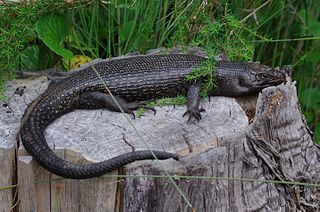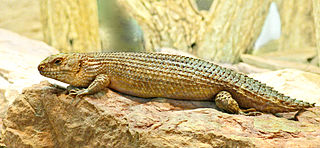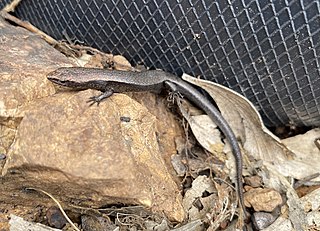
Egernia is a genus of skinks that occurs in Australia. These skinks are ecologically diverse omnivores that inhabit a wide range of habitats. However, in the loose delimitation the genus is not monophyletic but an evolutionary grade, as has long been suspected due to its lack of characteristic apomorphies.

The pink-tongued skink is a species of lizard in the family Scincidae. It is endemic to Australia, where it is also called commonly the pink-tongued lizard. As suggested by these common names, its distinguishing characteristic is a pink tongue as opposed to the blue tongue of lizards of the closely related genus Tiliqua.

King's skink is a species of skink, a lizard in the family Scincidae. The species is endemic to Australia.
The great desert skink, also known commonly as Kintore's egernia and by various other names including tjakura in various Aboriginal Australian languages, is a species of skink, a lizard in the family Scincidae. The species is native to the western half of Australia. It is a burrowing lizard and extremely social.

White's skink, also known commonly as White's rock skink, is a species of lizard in the skink family. It was first described in 1804 by French naturalist Bernard Germain de Lacépède. It is endemic to Australia.

Ctenotus strauchii, also known commonly as the eastern barred wedge-snout ctenotus or Strauch's ctenotus, is a small species of lizard in the family Scincidae. The species is endemic to Australia and is found throughout semi-arid and arid regions in most of Australia's mainland states except Western Australia, although one record does exist for Western Australia in 1975.

The Centralian blue-tongued skink or Centralian blue-tongue is a species of skink, occurring predominantly in the far north-west corner of New South Wales, Australia. It is one of six species belonging to the genus Tiliqua; the blue-tongued skinks and the shinglebacks. This species of reptile classifies as a lizard.

Egernia stokesii is a gregarious species of lizard of the Scincidae family. This diurnal species is endemic to Australia, and is also known as the Gidgee skink, spiny-tailed skink, Stokes's skink and Stokes's egernia. The species forms stable, long-term social aggregations, much like the social groups seen in mammalian and avian species. This characteristic is rarely found in the Squamata order, but is widespread within the Australian subfamily of Egerniinae skinks. Populations of E. stokesii are widely distributed, but fragmented, and occur in semi-arid environments. There are three recognised subspecies. The conservation status for the species is listed as least concern, however, one subspecies is listed as endangered.

The major skink is a species of lizard in the family Scincidae. The species is native to part of Australia and part of Australasia.

The eastern mourning skink, also known commonly as Coventry's spinytail skink and the swamp skink, is a species of lizard in the family Scincidae. The species is endemic to Australia.

Hosmer's spiny-tailed skink, also known commonly as Hosmer's egernia and Hosmer's skink, is a species of large skink, a lizard in the family Scincidae. The species is a diurnal, rock-dwelling species native to Northern Australia.

The black rock skink is a species of large skink native to Eastern and Southern Australia from central New South Wales to Grampians National Park in Victoria. A large, dark colored skink, up to 135 mm from snout to base of the tail, the black rock skink is the first reptile discovered to have a "nuclear family" structure where the parents form a pair and care for their offspring for more than one year. The black rock skink is a viviparous skink meaning females give birth to live offspring instead of laying eggs. They defend their home range and families against conspecifics for up to several years.
Egernia douglasi, also known commonly as the Kimberley crevice-skink, is a species of lizard in the family Scincidae. The species is endemic to Australia.

The desert egernia, unadorned desert-skink or desert skink is a species of skink, a lizard in the family Scincidae. The desert egernia is endemic to the continent of Australia, and is widespread, with populations recorded in all mainland states and territories except the Australian Capital Territory. The desert egernia is found in dry, desert areas with deep, uncompacted sandy/loamy soils and little significant vegetation cover.
Slater's desert skink, also known commonly as the Centralian Floodplains desert-skink, Slater's egernia, and Slater's skink, is a species of lizard in the family Scincidae. The species is endemic to Australia. There are two recognized subspecies.

Carinascincus coventryi, also known commonly as Coventry's window-eyed skink and the southern forest cool-skink, is a species of lizard in the family Scincidae. The species is endemic to Australia.

Cryptoblepharus buchananii, also known as Buchanan's snake-eyed skink, is a species of lizard in the family Scincidae. The species is endemic to Western Australia.
Menetia alanae, also known commonly as Alana's menetia and the Top End dwarf skink, is a species of lizard in the family Scincidae. The species is endemic to Australia.

Ctenotus essingtonii, also known commonly as Essington's ctenotus and the lowlands plain-backed ctenotus, is a species of skink, a lizard in the family Scincidae. The species is endemic to the Northern Territory in Australia.

Lerista kennedyensis, also known commonly as Kennedy's lerista, the Kennedy Range broad-blazed slider, and the Kennedy Range broad-striped slider, is a species of skink, a lizard in the subfamily Sphenomorphinae of the family Scincidae. The species is endemic to the Australian state of Western Australia.





















